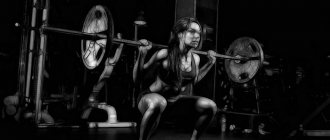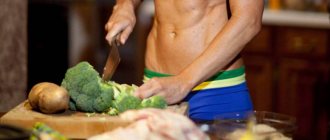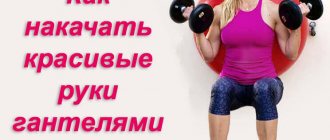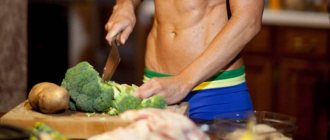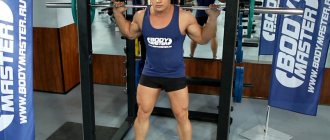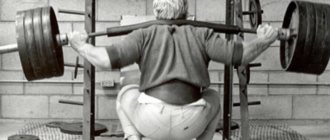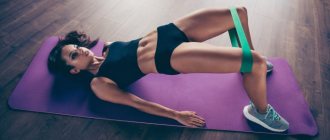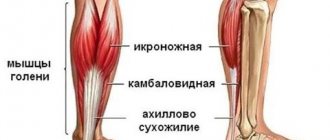You can give a beautiful shape and additional volume to your buttocks through various exercises. Squats were and remain the most effective and efficient. The main thing is to master the technique of execution. If you squat correctly and know what other exercises allow you to correct your shape, your butt will not only increase in volume, but will also become elastic. An understanding of the structure and function of the gluteal muscles plays an important role.
Anatomical features
The buttocks are formed by three posterior muscles - large, medium, small. Each performs its specific function. The large one is used when moving the legs to the sides and back, while straightening the torso, and occupies the largest area of the buttocks. The small one is located directly under the large one. Together with the middle one, they work only when the leg is abducted to the left and to the right.
The gluteus maximus muscle is most active during body extension. A similar load can be caused by doing:
- squats with weights - dumbbells or barbells;
- lunges;
- Romanian and deadlift;
- bending when a barbell rests on your shoulders.
Medium and small are involved in work when:
- swing your leg while lying on your side and from the lower block to the sides;
- leg extensions in a sitting machine;
- abducting the legs from a standing position with the machine lever.
Rules for all types of squats
- Warm up. This is the most important part of your glute workout. If you don't prepare your muscles for stress, you increase the likelihood of injury. You need to at least do running in place / running with high knees / jumping / swinging legs - for 3-4 minutes.
- Back position. If your back is not straight during squats, then the entire load will go not to the muscles of the buttocks, but to the lower back. Therefore, it is better for beginners to perform the exercise in front of a mirror.
- Neural connections. During the exercise you should feel the muscles of your buttocks. This is called neuromuscular communication - when you feel every muscle contraction and know how to tense it on command. To do this, you need to fully concentrate on doing the exercise.
- Speed. The faster you squat, the less muscles are used. The squat should be slow, measured and using the correct technique.
How to squat correctly
- Breathing cycle. Inhalation should be done in the first phase of the squat (when you began to move your hips back and squatted). Exhale - in the second phase (when you return to the starting position).
- Complicating the exercise. As soon as you stop feeling your muscles and get used to squats, they become much less effective. You can start doing the exercise with dumbbells or resistance bands, increase the number of repetitions, or change the type of squats.
With dumbbells
Interesting: 12 ways to force yourself to exercise
A little trick to increase the effectiveness of squats - regardless of their type. Every time you rise and straighten your knees, squeeze your buttocks. Every squat should end with this “compression”.
What are the benefits of squats?
Engaging multiple muscle groups is not the only benefit that exercise brings. Thanks to squats, physical fitness improves and the cardiovascular system is strengthened. If you squat regularly, not only will your buttocks change for the better, but your abdominal and back muscles will also become stronger. The pressure created in the chest during exercise improves the function of the respiratory organs, which helps saturate the body with large volumes of oxygen.
How does exercise help pump up the buttocks?
The only movement that allows you to use the large, medium and small muscles to the maximum is straightening the torso, and, therefore, squats are the best way to pump up these groups. And the lower you go, the more effective and efficient the exercise. Deep squats allow you to pump up and make your gluteal muscles elastic much faster.
Muscle strengthening occurs only when you work with weights. Training with weights helps muscles increase in volume. For each individual approach, 8-12 squats should be performed. After a cycle of repetitions, be sure to take a one- or two-minute break to rest.
You can't take light weight. The load must be noticeable. The correct choice is evidenced by the inability to perform more than 12 squats per approach. If there is no such refusal, the weights are too light. Of course, those who have never squatted with weights need to master the technique with a low load, and only then increase the weight at each session.
Squats. How to properly pump up your buttocks
How to start squatting?
As a child, in physical education classes, we all heard the words of the trainer: “20 squats, warm-up.” Not surprisingly, the exercise is suitable for performing in any conditions, be it at home or during a lunch break in the office. All this seems ordinary and easy, but the insidious technique of correctly performing squats is fraught with many pitfalls. Basic rules for performing squats:
Correct exercise technique is the key to your health, and health cannot be neglected. Simple rules for performing classic squats will help you save.
- Stay firmly on your heels while performing, even going down to the lowest point of the squat. Shifting your weight to your toes is highly discouraged due to the increased load on the ankle joint of the leg.
- Correct knee position. Pay attention to this recommendation when performing exercises with a load (barbell, dumbbells, weights). The knees should always be strictly parallel to the feet; it is extremely undesirable to bring them in or spread them wide. Follow the rule, thereby helping the body reduce the load on the knee joints and direct the benefits of the exercise to the desired muscle group.
- Keep your back straight throughout the entire exercise to reduce stress on your spine and the risk of injury.
- Take care of your cervical vertebrae. Keep your neck and head straight.
- Do not go too low during your first workouts; your body needs time to get used to the load.
Technique for performing squats with a barbell
You need to do the exercise technically correctly:
- The bar, located in a special power frame, is positioned at the level of the shoulder girdle. They approach the bar with their backs, and the bar is placed on the upper area of the trapezoid. It is forbidden to place the load on the vertebral sections of the neck. This is extremely dangerous.
- The barbell is removed from the rack and a couple of steps are taken forward. The legs are placed so that they are the width of the hip region. The socks can be spread slightly apart or placed strictly parallel to each other. The chin is kept slightly raised, which allows you to look up.
- Slowly squat while inhaling. The hips are lowered so that the knees do not extend beyond the toes, since this negatively affects the knee joints, but form a strictly right angle. The back is kept straight, the shoulder blades are brought together, the gaze is directed upward, the elbows are directed slightly back.
Important! You cannot round your lower back or move your body forward too much. The tailbone must be pulled back, because without this the muscles will not stretch and, therefore, grow in volume.
- With the force of the gluteal muscles, as you exhale, they rise upward, but faster than descending. The knees are straightened, the torso is extended. Having returned to the starting position, you should not completely straighten your knee joints, as this will remove the load from them.
Deep squat self-test
Starting position: feet shoulder-width apart, slightly turn your hips outward.
Test: Squat down so that your thighs are parallel to the floor, keeping your back straight. Stop and then return to the starting position.
Correct squat
Criteria for verification:
- the squat should be performed smoothly, without jerking;
- keep your back straight throughout the entire exercise;
- the knees are directly above the feet;
- don't lose your balance;
- the feet are completely pressed to the floor throughout the entire exercise;
- maintain a neutral head position.
To evaluate your performance according to all criteria, squat in front of the mirror: first facing it, and then sideways.
You can also ask a friend to follow your movements. It can be difficult to assess the position of the body ourselves, and in addition, we often lack self-criticism.
A good option is to ask to be filmed. You will be able to watch the video several times, evaluate your technique and notice any mistakes.
So, if you managed to perform the test perfectly, following all the criteria for correct technique, congratulations! You can perform squats with free weights without fear of injury.
If your technique does not correspond to the correct one according to any of the criteria, it means that weak or, conversely, tight muscles do not allow you to perform the exercise correctly. In this case, before picking up dumbbells or a barbell, you need to correct your mistakes.
What squats help you quickly and effectively increase your butt size at home?
Every girl can become the owner of beautiful and firm buttocks. The main thing is to set a goal and train regularly. It is not even necessary to visit the gym and exercise under the strict guidance of a trainer. You can also train at home. The exercises below, as well as important tips and tricks, can help you with this.
Classic with own weight
They are supposed to work exclusively with their own weight. Aimed at working the quadriceps, major, and adductor muscles. Without the use of weights, the lumbar extensors and core receive minimal load. It is a mistake to believe that the lack of load makes squats easier and simpler.
They are difficult for an unprepared person, since they are the most difficult exercises in physical education. It is certainly much easier to squat with your own weight (without weights), and even a beginner can easily master the technique. This allows you to tone your muscles so that after some time you can move on to working with a barbell.
Classic squats should be performed by those who need to prepare themselves for a serious load and understand the correct technique. This exercise is not suitable for pumping up your buttocks. It only tones the muscles, but does not increase volume.
Deep
They are a squat in which the pelvis is lowered so that it forms an acute angle at the knees, that is, it is below the level of parallel to the plane of the floor. This allows you to load both medium and large muscles well. Additionally, the work includes the adductors, lumbar, abdominal muscles and quadriceps. Thanks to a deep squat, it is the buttocks that are loaded, since they are the first to start working when lifting.
The range of motion increases, which increases tension and effort in the muscle fibers. And if the classic version does not give growth, then a deep squat, on the contrary, allows you to pump up your buttocks well. Not everyone can squat deeply. If your ankles are not flexible enough, this exercise will not be possible.
With a narrow stance
The legs are placed shoulder width apart. Close placement of the feet will not provide a stable position, so they must be slightly spread apart. Thanks to this pose, the middle and large, quadriceps, lumbar, adductor and abdominal muscles work. This squat allows you to optimally use the glutes, but it is only suitable if you have flexible ankles and ligaments, good length of the torso and hips.
For some, due to their physiological structure, it is difficult to squat from this position. If difficulties arise, then place your feet a little wider or turn your toes slightly. This allows you to achieve stability and properly load the muscles. The main thing is that while squatting, your thighs should be horizontal at the lowest point.
Sumo
Wide squats (sumo) work the adductor magnus, gracilis, middle and major quadriceps muscles. And if in a classic squat the adductor femoral muscles are minimally involved, then in this exercise they receive a significant load. This squat variation is not recommended to be performed in isolation. It should be done in combination and not on a regular basis, as it causes the inner thigh to increase in volume.
Curtsy
Cross lunges or curtsies are another variation of the squat. Its action is mainly aimed at the muscles of the buttocks medius and maximus and the quadriceps. The semimembranosus, semitendinosus, dorsal, abdominal muscles, as well as the hamstrings receive a small load.
The curtsy is a great addition to a leg training program. There are many different variations of cross lunges. They help to perfectly stretch the gluteal muscles. The only point is that the joints must be very flexible to perform such a squat.
With a kettlebell or dumbbells
The technique is no different from classic squats performed with a barbell. Similar muscle groups are involved. A significant advantage of dumbbells and kettlebells is that there is no compression on the spine. The use of these weights makes it possible for those who suffer from injuries and displacement of the vertebrae, osteochondrosis, intervertebral hernia, that is, cannot squat with weights on the shoulder area. This makes kettlebell dumbbells a great alternative to barbells.
"Plie"
This version of the squat got its name for its similarity to ballet technique. The exercise loads the adductor femoral, gluteus medius and gluteus maximus muscles. The work involves the quadriceps, abdominal muscles, and lower legs. To perform a plie squat, you need to have a fairly flexible hip joint.
The advantage of the exercise is that the quadriceps are not overloaded. However, given that the training is aimed at growing the buttocks, squats in this technique must be performed technically correctly. Lowering and lifting should be carried out not through the hips, but through the buttocks; it requires good concentration on the movements.
Deep on one leg or “pistol”
An excellent option for good development of the gluteal muscles. Working with your own weight allows you to provide an excellent load, but does not require the use of any additional sports equipment or equipment. Performing a pistol requires physical training. It is almost impossible for a beginner to master such a squat, so it is done when the muscles are already sufficiently prepared.
The greatest load falls on the large and quadriceps muscles. The downside is that such a squat is quite traumatic for the knee joints. This imposes certain restrictions. People suffering from pain or any problems with their knees should not do the pistol exercise.
With a barbell
Working with free weights during squats, if the technique is one hundred percent correct, allows you to make your buttocks firm and beautiful better than any other type of physical activity. Form formation occurs much faster when muscles serve as stabilizers, providing balance. The barbell option is contraindicated for people suffering from pain and spinal injuries.
Smith machine
An excellent squat machine that can replace the barbell option, but only temporarily. By working out in a Smith machine, you can prepare yourself for a real load in order to form a strong muscular corset and master the technique of using a barbell.
This makes the machine a great bridge between bodyweight, dumbbell, kettlebell, and shoulder-weighted squats. A simpler execution is achieved by relying on the bar and a stable position of the body with the knees, which allows you to properly load the quadriceps and glutes. You can squat in the machine with any position of your legs.
How is this exercise useful?
Coach Anna says that squats are very beneficial for the body. They use several muscle groups, thanks to which the body develops harmoniously. Joints and knee tendons are strengthened, coordination and posture are improved.
Squats are also safe for children, but in order for the child to immediately learn the correct technique, he must be supervised by a trainer.
5 effective exercises to tone your thighs
So, when you squat, you load your entire body. The work of the muscles will depend on the position of the back, legs and feet. An article in Flex magazine in 2011 reported that scientists in Denmark conducted a study that showed a link between leg size and heart health. Over 10 years, about 3,000 people were tested. The researchers concluded that high muscle volume protects against the development of cardiovascular disease and reduces overall mortality.
Photo: unsplash.com/@chrisjoelcampbell
Strong buttocks are not only beautiful, but also useful! Weak muscles increase the risk of problems in the lower back; they and the abs are responsible for the vertical position of the spine. By squatting, you will improve your reproductive functions as a bonus.
Anna Smirnova
PoleSport and aerial gymnastics coach
I squat daily with my own weight: in the morning during exercise and before training as a warm-up. For me, as an aerial artist, strong abs are very important, and squats help me pump them up.
You can exercise with your own weight. The buttocks will be 100% toned, but for voluminous shapes you will need additional weights. If you have contraindications, use the leg press, this will take the load off your spine.
4 rules of yoga for a healthy body
What is important to know before training?
- Make sure your back and legs are healthy. They receive a lot of stress during squats, so choose an appropriate weight or exercise with your own weight.
- Choose comfortable clothes and shoes. Nothing should stop you from moving.
- Do a 10-minute joint warm-up and warm up your muscles. This way you will protect yourself from possible injuries and increase the effectiveness of your training.
- Carefully study the technique of performing each movement or ask a trainer for help.
- Watch your back while doing the exercise. You can use an athletic belt. It helps to fix the spine in an upright position and avoid back injuries.
Photo: istockphoto.com
A set of squats for buttocks for 30 days
It consists of increasing the load every week, but at the same time reducing the number of repetitions in four approaches:
| Approach 1 | Approach 2 | Approach 3 | Approach 4 | |
| 1 Week | 20 | 15 | 12 | 12 |
| 2 week | 15 | 12 | 10 | 10 |
| 3 week | 12 | 10 | 10 | 8 |
| 4 week | 12 | 10 | 8 | 8 – 6 |
How to pump up your butt. Butt workout
Reasons for the absence or presence of muscle pain after training?
Any physical activity causes the muscles to feel tension, accompanied by microscopic tearing of the fibers. Unprepared muscle groups, as a rule, begin to hurt the next day after training. Painful sensations are in no way associated with lactic acid or lactate entering the gap. The latter stops after a maximum of four hours, and the pain does not go away until several days. The cause is the crack itself, that is, injury to the muscle fiber.
Proper loading is not accompanied by pain from rupture. Its complete absence also does not indicate the effectiveness of the training. Regular exercises gradually dull the discomfort of pain. When such a moment comes, it means it’s time to move on to heavier loads, but, of course, not excessive ones. Otherwise the pain will occur again.
How to choose the right weight of weights?
It is best to start squatting with your own weight. If possible, it is better to practice until the technique is fully mastered, under the guidance of a good trainer. The load is increased gradually. First you should take an empty bar. When the knees begin to remain motionless and the body does not fall forward, the weight is increased.
Weights should be chosen so that you can not only stand and squat with them, but also climb. You should add no more than 5 kg, and not every session. If 12 repetitions are easy, increase the weight, but reduce the number of repetitions slightly.
